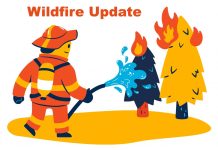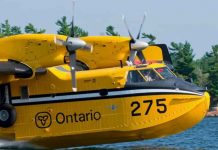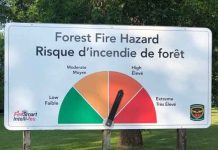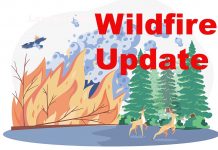Fire Hazard High to Moderate
THUNDER BAY – The forest fire hazard is moderate to high across the region with some areas of extreme hazard in the north.
There were two new fires in the Northwest Region by the afternoon of August 25 and a total of five new fires in the region by the end of August 24 bringing the total number of active fires in the region to 135.
Incident management teams in the region are working on Nipigon District Fire Number 99 northeast of Nipigon as well as fire complexes in the far north around Nibinamik and Kitchenuhmaykoosib Inninuwug (KI). Good progress is being reported on all of the fires.
Mop-up continues on Nipigon District Fire Number 099. Crews have been digging out hot spots on this fire with the use of hand tools, pumps, and heli-bucketing. There is a travel advisory in place to ensure firefighter and public safety. Individuals travelling the Camp 81 Road may encounter closures to some spur roads (e.g. Main Road 7) to ensure safety and support fire suppression. Recreational users may want to consider alternate routes like the Lachance or Gorge Creek roads instead.
A fire is being monitored on Lac Seul in the Sioux Lookout District. SLK123 is being managed under the Lac Seul Conservation Reserve Fire Response Plan to restore and maintain the ecosystem on the island. This fire is within the Lac Seul Islands Conservation Reserve and is not being extinguished in order to achieve the ecological benefits of natural fire on the landscape. Signs are posted on the island alerting the public to the fire situation and advising the public to keep a safe distance away from the island until the fire has been called out and all signs have been removed.
To track the fire hazards and to see a complete list of fires across the province click on our interactive map.
Provincial Resources Bolstered by Quebec and US Firefighters
Resources from Quebec and the United States arrived last week to provide support to Ontario during its escalated forest fire situation caused by multiple fire starts from lightning strikes. A fire behaviour analyst from Quebec was deployed to the Northwest Region, and as part of a Great Lakes Forest Fire Compact (GLFFC) agreement there are 15 firefighters from the states of Michigan and Wisconsin currently assigned to a fire in the northern sector of the Northwest Region.
Due to a recent easing of the fire situation in Ontario in the past few days, resources can be provided to support the emergency forest fire situation in British Columbia. There are 81 personnel from Ontario currently in British Columbia providing structural protection, fire investigation, public information and firefighting support. There is also equipment, including ten thousand lengths of hose, pump kits and two structural protection units. There is also one person supporting the Canadian Interagency Fire Centre.
Additional resources are scheduled to deploy to British Columbia on August 25 including a Type 1 Incident Management Team that will be joined by a research scientist from Quebec, two (4-person) Type 1 Initial Attack crews, overhead staff and structural values protection personnel.
As part of normal rotation of staff deployed out of province, there will also be personnel returning from assignment in British Columbia this week and early next week.
Planning to have a campfire?
Here are some tips on how to safely enjoy your campfire and avoid the costs and dangers that can arise from an unextinguished or unattended campfire:
- Choose your site carefully. Select a site with easy access to water that is sheltered from high winds. The fire must be built on bare rock or non-combustible material.
- Prepare the site. Clear a one metre space around your campfire site and remove all pine needles, grasses, leaves and twigs.
- Keep your fire small. By law, your campfire cannot exceed one metre in height and one metre in diameter.
- Stay nearby. Never leave your campfire unattended.
- Put your fire out. Soak your fire with water.
- Be sure the fire is extinguished. Stir the ashes with a stick to uncover hot coals and then soak it again!
Fire numbers and online information:
- Forest Fire Reporting Number – 310-FIRE (3473)
- Follow us on Twitter: in English @ONForestFires or in French @ONFeuDeForêt
- For guidelines on safe outdoor fire management ontario.ca/fireprevention





